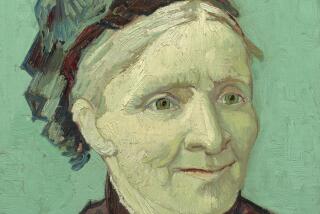PLATINUM HITS : Finding inspiration in the past, photographers give new texture to an old vision.
- Share via
Photographer J. Michael Lardizabal spent years realizing his “platinum vision.”
The Santa Monica-based artist was first struck by the subtle range and exquisite detail of a platinum palladium print exhibited in a show at the J. Paul Getty Museum in Malibu about 10 years ago. The encounter was a revelation.
“I said ‘God, this is the way to make a photograph,’ ” he recalls.
Now, Lardizabal’s own platinum palladium photographs and works by five other photographers can be seen locally in “Platinum Visions: Contemporary Platinum Photography” opening tonight with a reception at 8 in the Norris Film Gallery of the Palos Verdes Art Center. The exhibit runs through July 31.
The group show features the work of co-curator Lardizabal, whose photographs also can be found at the Metropolitan Museum of Art in New York and the Norton Simon Museum in Pasadena; Dick Arentz of Arizona, whose work hangs in the Corcoran Museum in Washington and the Smithsonian Institution, and of Doug Frank and Harrison Branch from Oregon, Fred Byrum from Seattle and Dana Strout from Colorado.
Photographs printed on platinum-based paper lack the high contrast blacks and whites found in silver gelatin prints. Instead, the images are created in a subtle range of grays.
All the photographs in “Platinum Visions” are contact prints produced with large format view cameras and ranging from 8 by 10 to 12 by 20. The use of such large negatives results in delicately detailed urban landscapes, and scenic vistas from the American West and Europe.
The exhibit includes Frank’s ethereal photograph of the Oregon desert, the only image in the show shot with a pinhole box camera; Strout’s striking photograph of the street on which poet Robert Burns lived in Edinburgh, Scotland, and Lardizabal’s visual explorations of the California wetlands.
Phil Loman, the art center’s volunteer co-curator, praised the artists for their “craftsmanship and control of the medium.”
Using platinum in print photography is not new. The process dates back to the late 1800s and renowned photographers such as Edward Westin, Paul Strand and Imogene Cunningham all used platinum- treated paper as their “paper of choice,” Lardizabal said.
But during World War I, platinum was gobbled up for military use and became expensive and difficult to obtain. Artists turned instead to paper treated with silver-based compounds, Lardizabal said.
The use of platinum began to regain popularity in the 1960s and is available commercially today, but most photographers who use it make it themselves.
Lardizabal, for example, hand mixes a concoction that includes platinum and palladium with iron salts, and brushes the mixture onto 100% rag cotton paper.
When the paper dries, it is sensitive to ultraviolet light. Prints can be developed in sunlight or by lights similar to those found in a tanning salon.
“The beauty about this process is it’s almost like an engraving,” Lardizabal said. “In the usual glossy paper used in commercial black and white photographs, the image floats on top of the paper. In the platinum process the image becomes embedded in the paper.”
As a result, photos developed with a platinum-treated paper will last as long as the paper itself, he said. A black and white silver gelatin print may fade and tarnish within 75 years. A platinum palladium print could last up to 2,000 years, Lardizabal said.
“There are very few things a man can make that can last that long,” he said.
But the price of longevity is high. Creating platinum palladium prints can run a photographer up to 16 times the cost of a silver gelatin print, Lardizabal said. Ten grams of platinum powder, about the amount needed for an expert printer to create 20 to 25 prints, costs about $210.
So while producing 25 silver gelatin black and white 8-by-10 photos might cost an artist little more than $1 each, the same number of platinum prints could run from $400 to $500.
“Not many have the patience or the money to work in platinum,” Lardizabal said.
But the results are worth the effort and expense, he added.
“It’s a wonderful hands-on process,” he said.
The Norris Film Gallery of the Palos Verdes Art Center is located at 5504 W. Crestridge Road in Rancho Palos Verdes. Admission is free and by appointment only. The art center is open Monday through Friday from 9 a.m to 4 p.m. and Saturday from 1 p.m. to 4 p.m. Information: (310) 541-2479.
More to Read
The biggest entertainment stories
Get our big stories about Hollywood, film, television, music, arts, culture and more right in your inbox as soon as they publish.
You may occasionally receive promotional content from the Los Angeles Times.










